Chinese food culture(中国饮食文化)
- 格式:ppt
- 大小:3.17 MB
- 文档页数:40
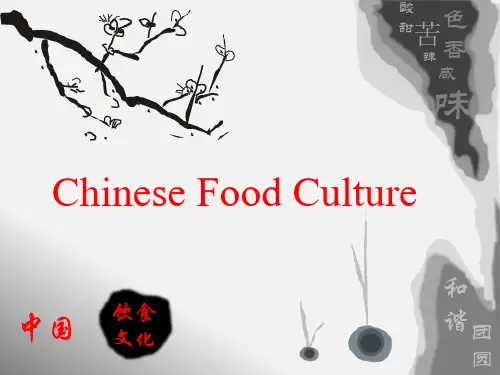

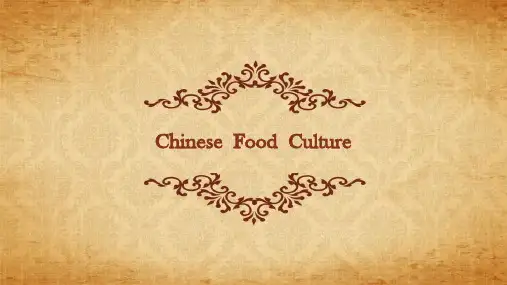

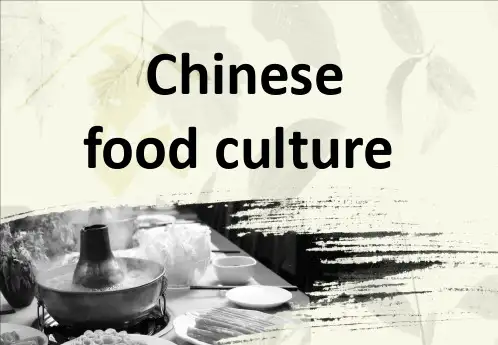
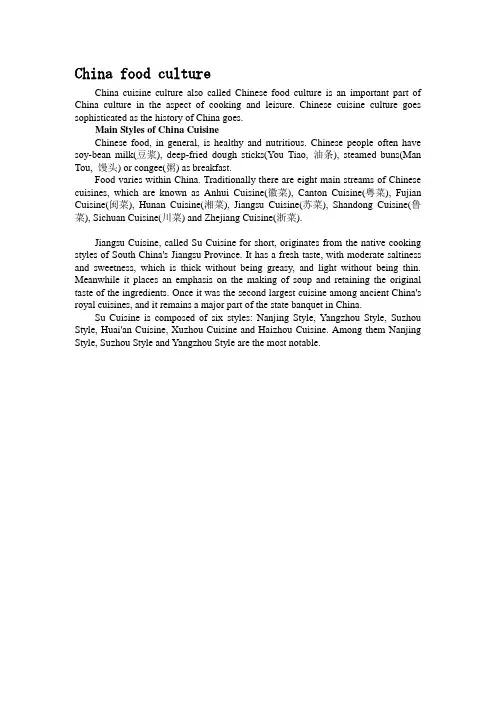
China food cultureChina cuisine culture also called Chinese food culture is an important part of China culture in the aspect of cooking and leisure. Chinese cuisine culture goes sophisticated as the history of China goes.Main Styles of China CuisineChinese food, in general, is healthy and nutritious. Chinese people often have soy-bean milk(豆浆), deep-fried dough sticks(You Tiao, 油条), steamed buns(Man Tou, 馒头) or congee(粥) as breakfast.Food varies within China. Traditionally there are eight main streams of Chinese cuisines, which are known as Anhui Cuisine(徽菜), Canton Cuisine(粤菜), Fujian Cuisine(闽菜), Hunan Cuisine(湘菜), Jiangsu Cuisine(苏菜), Shandong Cuisine(鲁菜), Sichuan Cuisine(川菜) and Zhejiang Cuisine(浙菜).Jiangsu Cuisine, called Su Cuisine for short, originates from the native cooking styles of South China's Jiangsu Province. It has a fresh taste, with moderate saltiness and sweetness, which is thick without being greasy, and light without being thin. Meanwhile it places an emphasis on the making of soup and retaining the original taste of the ingredients. Once it was the second largest cuisine among ancient China's royal cuisines, and it remains a major part of the state banquet in China.Su Cuisine is composed of six styles: Nanjing Style, Yangzhou Style, Suzhou Style, Huai'an Cuisine, Xuzhou Cuisine and Haizhou Cuisine. Among them Nanjing Style, Suzhou Style and Yangzhou Style are the most notable.。
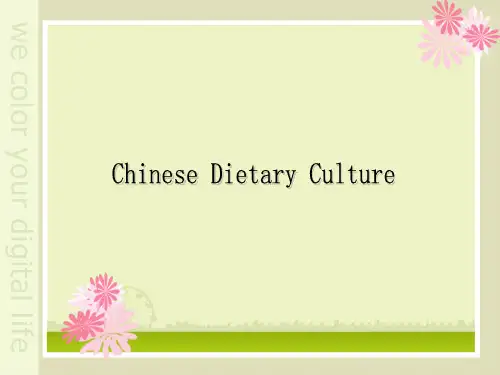
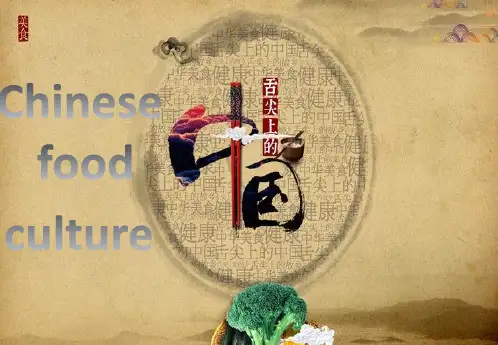
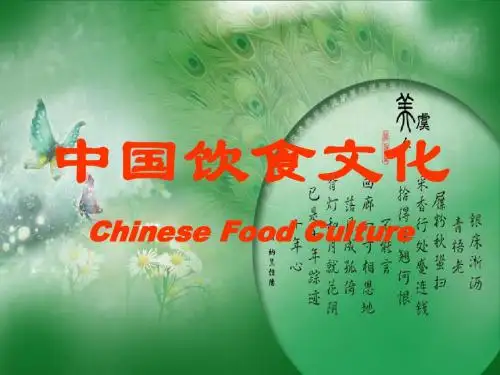
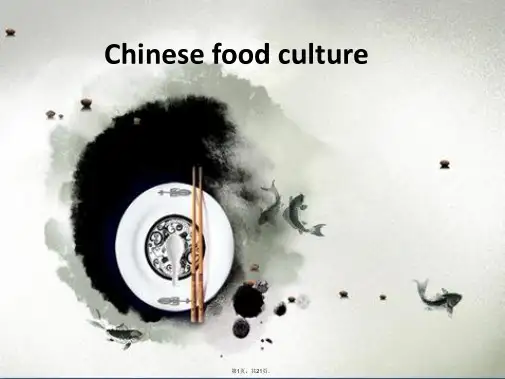
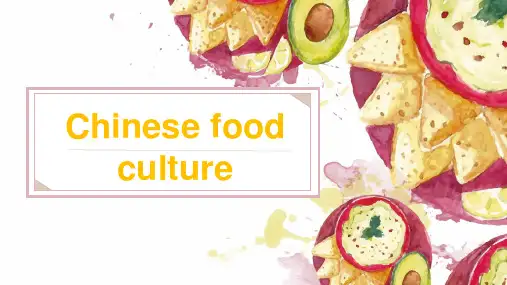
中国饮食文化英语作文带翻译The Chinese food culture is an important part of the traditional Chinese culture. Its unique cooking techniques and ingredients create different flavors, so that many foreigners like to taste Chinese food.Chinese food culture has a long history. It began in the early Neolithic Age 5,000 years ago and developed over the centuries. It includes various cuisines, such as Sichuan cuisine, Cantonese cuisine, Hunan cuisine and Shandong cuisine. Each region has its own unique cooking process, ingredients and flavor.Chinese dishes are not only delicious but also nutritious. Chinese people pay attention to the balance of nutrition when cooking. Chinese dishes are usually cooked with many kinds of vegetables and meat, which can provide comprehensive nutrition for us.中国饮食文化是中国传统文化的重要组成部分。
其独特的烹饪技术和食材创造出不同的味道,让许多外国人都喜欢品尝中国菜。
Chinese Food: The Enchanting Cultureof Chinese CuisineThe Regional Diversity of Chinese CuisineChina's vast territory and diverse ethnic groups have given rise to a multitude of regional cuisines, each with its unique characteristics. From the spicy and bold flavors of Sichuan cuisine to the delicate and subtle tastes of Cantonese cuisine, Chinese food offers a gastronomic journey that is both exciting and enlightening.Sichuan Cuisine: A Spicy DelightCantonese Cuisine: A Symphony of FlavorsCantonese cuisine, also known as Guangdong cuisine, is known for its light and fresh flavors. Dim sum, a Cantonese specialty, is a delightful array of small dishes, including steamed dumplings, savory buns, and delicate pastries. The emphasis on fresh ingredients and precise cooking techniques makes Cantonese cuisine a favorite among food connoisseurs.The Cultural Significance of Chinese CuisineThe Art of Chinese CookingChinese cooking is a blend of art and science, with techniques passed down through generations. The wok, a versatile cooking utensil, is central to Chinese cuisine.Stirfrying, a quick and highheat cooking method, is used to create dishes like Beef and Broccoli and Kung Pao Chicken, ensuring that ingredients remain fresh and vibrant.In conclusion, Chinese cuisine is a treasure trove of flavors, traditions, and stories. By exploring the diverse regional cuisines and understanding the cultural significance behind each dish, one can gain a deeper appreciation for the enchanting culture of Chinese food.The Philosophy Behind Chinese Culinary ArtsThe Importance of Seasonality and FreshnessChinese culinary traditions place a strong emphasis on the use of seasonal ingredients. The belief is that food should be consumed when it is at its peak of freshness and flavor. This respect for nature's rhythm ensures that diners enjoy the best that each season has to offer. From spring's tender bamboo shoots to winter's hearty root vegetables, the changing of the seasons is celebrated on the Chinese dining table.The Role of Tea in Chinese CultureThe Art of Table Manners and EtiquetteThe Future of Chinese CuisineAs Chinese cuisine continues to captivate the world, it is evolving while maintaining its traditional roots. Young chefs are experimenting with fusion styles, blendingtraditional Chinese flavors with international influences.This innovation is breathing new life into classic dishes, making Chinese cuisine more accessible and appealing to a global audience.The Spiritual Connection of Food and FestivalsIn the tapestry of Chinese culture, food plays a pivotal role during festivals and holidays, symbolizing wishes, traditions, and spiritual beliefs. Each festival brings withit a array of special dishes, each carrying its own meaning and significance.The Lunar New Year, or Spring Festival, is perhaps the most celebrated of all. Families gather for a grand feast known as the "Reunion Dinner," where dishes like fish (symbolizing surplus and prosperity), dumplings (shaped like ancient Chinese money and representing wealth), and nian gao (a sweet sticky rice cake signifying growth and progress) are served. These foods are not only delicious but are also eaten with the hope of bringing good fortune for the year ahead.The Art of Presentation and AestheticsChinese cuisine is not only about taste but also about presentation. The arrangement of dishes on a table is an art form in itself, with an emphasis on color, shape, and balance. The goal is to create a visual feast that excites the eyes before the food even touches the lips. This aestheticapproach is evident in the intricate carvings of vegetables and fruits used as garnishes, and in the careful placement of ingredients to form patterns and pictures on the plate.The Legacy of Chinese Culinary TechniquesThe legacy of Chinese cooking techniques is a testament to the ingenuity and resourcefulness of its people. Methods such as red cooking (braising in soy sauce), white cooking (simmering in water or stock), and the delicate art of dim sum making are passed down through generations. These techniques not only enhance the flavors and textures of the ingredients but also preserve the nutritional value of the food, reflecting the Chinese philosophy of health and wellness through diet.The Global Reach of Chinese CuisineIn essence, Chinese cuisine is a living history book, each page filled with stories of tradition, innovation, and the joy of sharing. It is a journey that invites all to partake, a celebration of flavors and cultures that continues to inspire and delight palates worldwide.。
Chinese Food Culture1.Characteristics of cuisines in southern part of ChinaChinese cuisine has a number of different genres, but the most influential and typical known by the public are the 'Eight Cuisines'. These are as follows: Shandong Cuisine, Guangdong Cuisine, Sichuan Cuisine, Hunan Cuisine, Jiangsu Cuisine, Zhejiang Cuisine, Fujian Cuisine and Anhui Cuisine.We have roughly separated Chinese cuisine into two genres. They are Cuisines of the north part and the southern part. Cuisines of the southern part of China are really featured. They have various differences with northern cuisine.Firstly, abundant rain drops and sunlight in South China provide favorable conditions for the growth of millet and rice. Compared with people in North China who have to spend much time in cold weather, people in South China are less preferable to meat diet, which contains lots of fat and protein. Southern Chinese prefer plant diet quite a lot. Many people are accustomed to drink soup both before and after the meal. Guangdong Soup(老火靓汤)Secondly, South China is one of the most developed areas in China. It welcomes people from the entire world. As a result, Southern Cuisine, especially Guangdong Cuisine, emphasizes a flavor which is clear but not light, refreshing but not common, tender but not crude.Thirdly,People in South China tend to be more careful and sensitive than northern people. As a result, their dishes as well as appearance are really cute and attractive. Just like dim sum(点心), which means “touch the heart”, is one of the most famous Cantonese meal. It consists of a variety of delicacies and is usually served for breakfast or dinner.Spicy-hot Fish麻辣鱼Mapo Tofu (Stir-Fried Tofu in Hot Sauce)麻婆豆腐Pork Rips排骨)Penaeus orientalis对虾2.Characteristics of cuisines in northern part of ChinaCuisines of the north part of China have several characteristics.people in the north tend to eat cooked wheaten food. Or in other words, people eat more food made of flour. This is because the climate here is temperate continental climate, which means there are less rain drops and sunlight. And this climate provides favorable conditions for the growth of wheat.First,When it comes to cooked wheaten food, there is a place many people are familiar with. That is Shanxi(山西). As the saying goes, “east or west, Shanxi cooked wheaten food is best”. Shanxi is famous for its diverse and delicious cooked wheaten food. With a history of 2000years, Shanxi cooked wheaten food is gaining more and more popularity at home and even abroad.Cooked wheaten food in Shanxi,there are round 280 kinds of cooked wheaten food, among which the sliced noodles is the most renowned one.Apart from the sliced noodles刀削面, boiled food also includes hand-pulled noodles拉面, He lao饸饹)Tijian,剔尖Maoerduo猫耳朵, Jiupian(揪片) ,which are all delicious and tasty.As for the cooked food, it includes fried cake(炸糕)、Yi wo su(一窝酥)、fried dough twist (麻花),Shuai bing(甩饼) and so on.Other steamed wheaten food includes steamed bun、You mian kao lao(莜面栲栳)、Gao liang mian yu(高粱面鱼).Second, food in the north is often more salty and greasy than that in the south.Because people like to add more ingredient to dishes even the soup.Shandong cuisine and Beijing cuisines are two famous cuisines of the eight cuisines in china. And they are also representatives of the northern cuisines. Beijing cuisine is famous for its Beijing roast duck and instant-boiled mutton. Shandong food is always pure, fresh, tender, salty and crisp.Chinese people pay much attention to eating, not just to fulfill our basic needs, but deep within, it contains the measures Chinese people take to understand things. For example, when a child was born, relatives and friends would eat eggs painted in red color to celebrate. Eggs symbolize new lives, eating red eggs embodies the high expectations of the Chinese to carry on the family line. We have feasts in the weddings; we celebrate our birthdays with gatherings and delicious food; we gather with our friends or families to eat, which is a good way to enhance our intimacy.People gathering to celebrate with big feastsIn sum, Chinese food culture has gained much popularity throughout the world, and in the modern era, the popularity still thrives. Food culture, which has great influence to Chinese people’s personalities, has already become one of the fine traditional cultures in China. With the enhancement of the globalization, Chinese food culture would become better known across the world.。
中国饮食文化1. IntroductionChina’s food culture is rich and diverse, and has a history that dates back thousands of years. It is not only about the flavors and tastes, but also the traditions, customs, and symbolism associated with the food. Chinese cuisine is considered one of the most popular and influential cuisines in the world, with a wide range of regional specialties.2. Regional CuisineChina is a vast country with diverse geographic and climatic conditions, which have given rise to a wide variety of regional cuisines. Some of the popular regional cuisines include:2.1 Sichuan CuisineSichuan cuisine is known for its bold flavors, use of spices, and numbing sensation due to the Sichuan peppercorns. Popular dishes include Kung Pao Chicken and Mapo Tofu. Sichuan cuisine is characterized by its mala (numbing and spicy) flavor.2.2 Cantonese CuisineCantonese cuisine is famous for its dim sum, seafood, and delicately prepared dishes. It emphasizes the freshness and natural flavors of the ingredients. Popular dishes include Steamed Dim Sum, Roast Duck, and Sweet and Sour Pork.2.3 Shandong CuisineShandong cuisine is known for its seafood dishes, as the province is located along the coast. It features a combination of flavors, including salty, sweet, and sour. Popular dishes include Braised Abalone and Sweet and Sour Carp.2.4 Hunan CuisineHunan cuisine is characterized by its spicy and savory flavors. It often uses pickled vegetables and chili peppers to create bold and intense tastes. Popular dishes include Spicy Crispy Pork and Stir-Fried Cabbage with Chili.2.5 Jiangsu CuisineJiangsu cuisine is known for its delicate and subtle flavors. It is often associated with the Shanghai style of cooking. Popular dishes include Braised Lion’s Head Meatballs and Beggar’s Chicken.3. Traditional Chinese Food CustomsChinese food customs are deeply rooted in tradition and symbolize various aspects of Chinese culture. Here are some of the common food customs:3.1 Dining EtiquetteChinese dining etiquette emphasizes respect and consideration for others. It is customary to wait for the elders to start eating before others begin. Chopsticks should not be left sticking upright in a bowl, as it is considered impolite.3.2 Lucky FoodsCertain foods are believed to bring good luck and fortune in Chinese culture. For example, fish symbolizes prosperity, and dumplings symbolize wealth and good fortune. These foods are often served during festivals and special occasions.3.3 Festival FoodsChinese festivals are often accompanied by specific food traditions. For example, during the Lunar New Year, a reunion dinner is prepared, which includes dishes with symbolic meanings, such as whole fish for abundance and rice cake for prosperity.4. Modern Chinese CuisineWhile traditional Chinese cuisine remains popular, modern Chinese cuisine has also gained recognition in recent years. Chefs have started experimenting with fusion dishes, incorporating Western ingredients and cooking techniques into Chinese cuisine.5. ConclusionChinese food culture is rich in flavors, traditions, and symbolism. It not only satisfies the taste buds but also reflects the values and beliefs of Chinese society. Whether it is the spicy Sichuan cuisine or the delicate Cantonese dishes, Chinese cuisine continues to captivate people around the world, making it a prominent part of global culinary traditions.Note: This document is written in Markdown format. Markdown is a lightweight markup language that allows for easy formatting and conversion to HTML.。